Part 16: December 17 Broadcast

You are listening to BBC radio 4. In an hour, we’ll be looking into the history of St. Nicholas, starting from the Roman years. For the next hour, Professor David Stephenson will be presenting a documentary on the second 80 years war of the eighteenth century. This series will be running every third day, up to 50 episodes. If you want news of the current war in the Middle East please channel in to BBC radio 1.
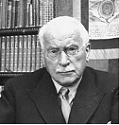 Good evening, and welcome to BBC radio 4. I’m Professor David Stephenson, professor of Dutch historical studies at Cambridge. This is the sixteenth part of our 50 episode special on the second 80 years war over Europe. Joining me for these broadcasts are fellow researchers and scholars Doctor Albert Andrews, specialist in German studies from the Berlin academy, Professor Robert Lowe, specialist in French studies at Cambridge, and a graduate student and technical assistant, Anton Thatcher. Last week, we discussed the defensive years of 1726 through 1728.
Good evening, and welcome to BBC radio 4. I’m Professor David Stephenson, professor of Dutch historical studies at Cambridge. This is the sixteenth part of our 50 episode special on the second 80 years war over Europe. Joining me for these broadcasts are fellow researchers and scholars Doctor Albert Andrews, specialist in German studies from the Berlin academy, Professor Robert Lowe, specialist in French studies at Cambridge, and a graduate student and technical assistant, Anton Thatcher. Last week, we discussed the defensive years of 1726 through 1728. The Dutch defense of their territory continued up through 1729 and into the new decade. However, with the Dutch stalled at their fronts, and the citizenry of India and America tired of the constant raids, the voting populace wanted blood. The Republican party with their Fabian strategy had some difficulty in convincing their people that they had what was needed to defeat their enemies. At the time, the thought of attaining peace was not at the forefront of the majority within the United Provinces, and so it was easy for the Orange party to lobby on the fact that the Republicans were sitting back hoping for peace treaties, which was partly true. The Republican party had approached Austria and Britain hoping for peace, but were at the time unable to attain it.
The Dutch defense of their territory continued up through 1729 and into the new decade. However, with the Dutch stalled at their fronts, and the citizenry of India and America tired of the constant raids, the voting populace wanted blood. The Republican party with their Fabian strategy had some difficulty in convincing their people that they had what was needed to defeat their enemies. At the time, the thought of attaining peace was not at the forefront of the majority within the United Provinces, and so it was easy for the Orange party to lobby on the fact that the Republicans were sitting back hoping for peace treaties, which was partly true. The Republican party had approached Austria and Britain hoping for peace, but were at the time unable to attain it.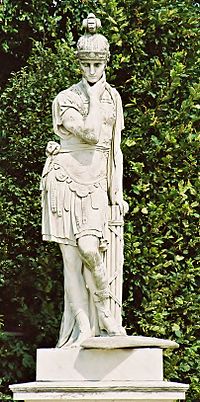
The Dutch cabinet was seen as similar to Quintus Fabius Maximus, who had secured Rome's position against Carthage by waiting. The reality was similar, though the Dutch had a more firm timeline set to attack.
 With that in mind, the Dutch would have to advance. However, in Germany, a sudden change occurred. General Ouwerkerk had died of a heart attack.
With that in mind, the Dutch would have to advance. However, in Germany, a sudden change occurred. General Ouwerkerk had died of a heart attack.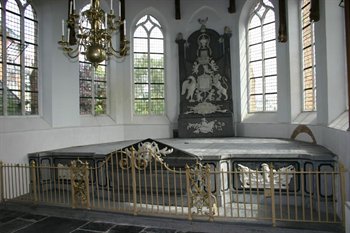
The grave and monument of Lord Ouwerkerk.
 Ouwerkerk, the heart of the Dutch army, their most experienced general, and the champion of the militia had passed October 17, 1728. He was replaced by the younger Huub Vanderbilt, who had no experience whatsoever, and who had no faith in the famed Dutch militia.
Ouwerkerk, the heart of the Dutch army, their most experienced general, and the champion of the militia had passed October 17, 1728. He was replaced by the younger Huub Vanderbilt, who had no experience whatsoever, and who had no faith in the famed Dutch militia.
Huub Vanderbilt was hired primarily on the laurel that he was in Germany at the time. He had been a rather unremarkable officer until then.
 Now the Dutch were without a military leader with the faith in the militia army that was in Munich, leaving it behind to merely police the state. They could not rely on those battalions to form the basis of a new army sent to Britain, as no living general wished to lead it on to Britain to fight the newly reformed British army collected around Portsmouth.
Now the Dutch were without a military leader with the faith in the militia army that was in Munich, leaving it behind to merely police the state. They could not rely on those battalions to form the basis of a new army sent to Britain, as no living general wished to lead it on to Britain to fight the newly reformed British army collected around Portsmouth. With Waaldeck and Ouwerkerk dead in Europe, and Coster in India retired, the Dutch were down to relatively new generals. Without any of their famed generals who had led them through their hardest years around 1710, this new wave was far more timid, far less innovative and far less experienced. Where Ouwerkerk would have fought a battle outnumbered two to one, new generals wished only to engage in battle where they could outnumber the enemy by a few hundred men. The dream of a quick consolidation of forces in the East to the West coast to invade Britain had just slipped from the hands of the Dutch.
With Waaldeck and Ouwerkerk dead in Europe, and Coster in India retired, the Dutch were down to relatively new generals. Without any of their famed generals who had led them through their hardest years around 1710, this new wave was far more timid, far less innovative and far less experienced. Where Ouwerkerk would have fought a battle outnumbered two to one, new generals wished only to engage in battle where they could outnumber the enemy by a few hundred men. The dream of a quick consolidation of forces in the East to the West coast to invade Britain had just slipped from the hands of the Dutch.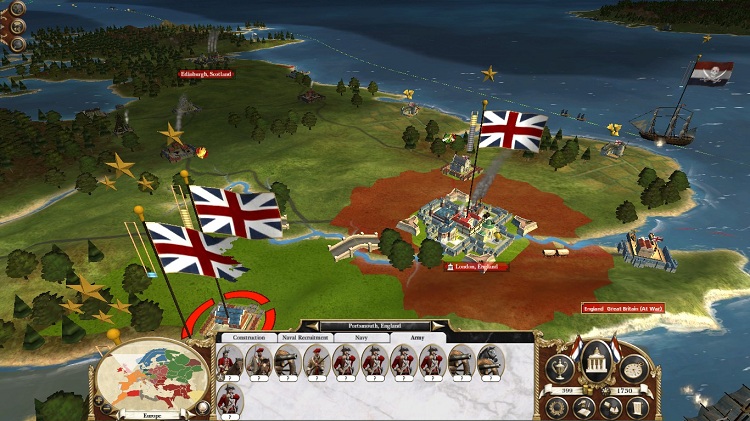
While the British had created a new highly professional army around Portsmouth, the Dutch could no longer abandon Germany to a limited defense while committing a second army to Britain.
 Only in the Americas were the Dutch finding themselves wary of war. With small, relatively underfunded armies and beset by massive Cherokee forces and staring down the British army along the East coast, the American Dutch had to fight difficult battle after difficult battle that were slowly whittling them down.
Only in the Americas were the Dutch finding themselves wary of war. With small, relatively underfunded armies and beset by massive Cherokee forces and staring down the British army along the East coast, the American Dutch had to fight difficult battle after difficult battle that were slowly whittling them down.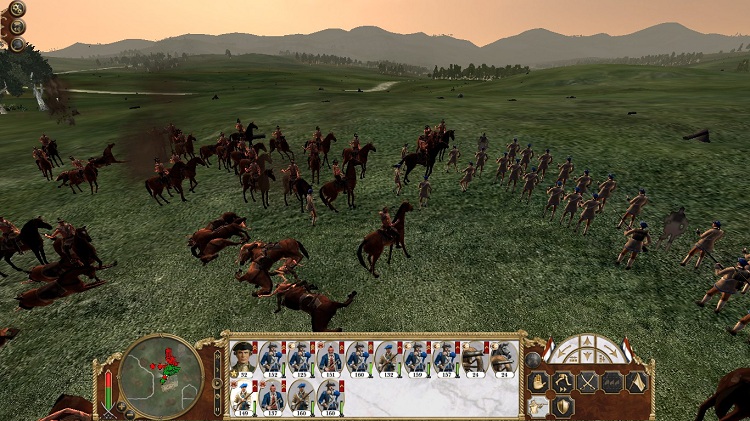
In North America, the Dutch assessment of the strength needed to defeat the Cherokee was accurate, but the Dutch were finding themselves worn down with little to show for it.
 That changed in 1728 when the British fleet and their army appeared north of Hispanolia. With Florida practically empty, their second army entrenched fighting the Cherokee, and their Savannah army needed north to counter the British just a day’s march away from them, the Dutch now faced the same reality they had when their flank was threatened by the British garrison in the Bahamas.
That changed in 1728 when the British fleet and their army appeared north of Hispanolia. With Florida practically empty, their second army entrenched fighting the Cherokee, and their Savannah army needed north to counter the British just a day’s march away from them, the Dutch now faced the same reality they had when their flank was threatened by the British garrison in the Bahamas.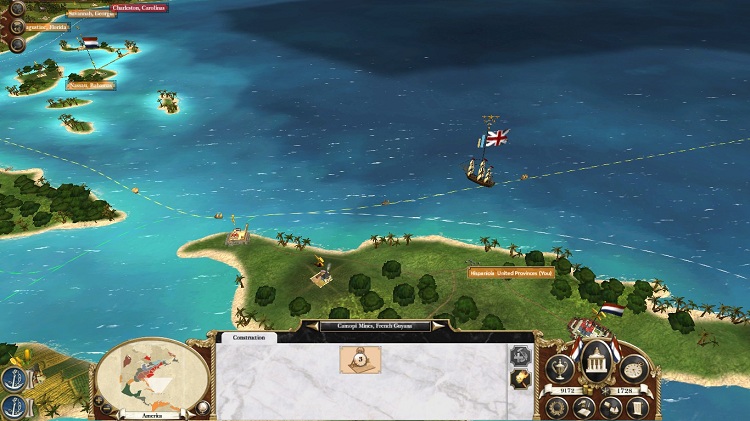
The Dutch spot the British fleet approaching. Willing to abandon their islands to stave off an advance on the mainland, recruitment quintupled in the Americas.
 The British made landfall just outside Florida in 1729, attacking in November. The Dutch having been somewhat forewarned fell into a bit of a panic, suddenly mass recruiting across every province they held in North America, spending tens of millions of guilders that previously would never have been spent on the American theater.
The British made landfall just outside Florida in 1729, attacking in November. The Dutch having been somewhat forewarned fell into a bit of a panic, suddenly mass recruiting across every province they held in North America, spending tens of millions of guilders that previously would never have been spent on the American theater.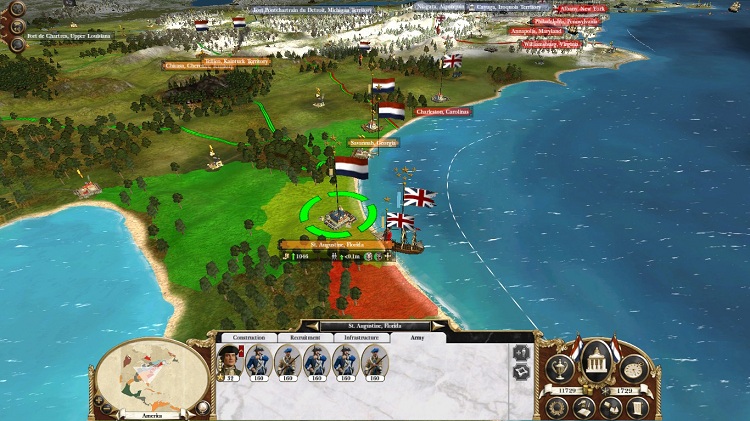
The British which had been missing for nearly three years appear near Florida.
 The fort in St. Augustine had been garrisoned by several hundred men, and two batteries of cannons, while Savannah had one thousand five hundred, with no cannon. The United Provinces were forced to split the Savannah garrison to protect Florida, as they couldn’t afford being surrounded by the British. The cannon on the other hand, were sent north to Savannah, as they wouldn’t be useful in the Florida fortress. This left both forces as close to equal as they could be given the circumstances. This was aided by the Dutch ignoring the tally of horse in Florida, which freed even more men to move to Savannah.
The fort in St. Augustine had been garrisoned by several hundred men, and two batteries of cannons, while Savannah had one thousand five hundred, with no cannon. The United Provinces were forced to split the Savannah garrison to protect Florida, as they couldn’t afford being surrounded by the British. The cannon on the other hand, were sent north to Savannah, as they wouldn’t be useful in the Florida fortress. This left both forces as close to equal as they could be given the circumstances. This was aided by the Dutch ignoring the tally of horse in Florida, which freed even more men to move to Savannah. Their other army in the west facing the Native Americans were trying as best they could to defeat the Cherokee as quickly as possible, so they could reinforce the main Dutch force along the east coast. To this end, they sought to knock the Cherokee out of the war as quickly as possible.
Their other army in the west facing the Native Americans were trying as best they could to defeat the Cherokee as quickly as possible, so they could reinforce the main Dutch force along the east coast. To this end, they sought to knock the Cherokee out of the war as quickly as possible.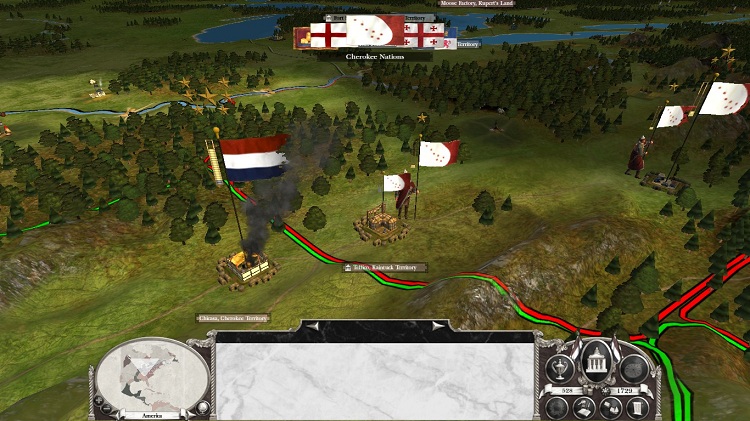
The Dutch were advancing very quickly through the native Cherokee. Here, the Dutch have pushed back a limited Cherokee counter attack just as they'd settled into their territories. The Dutch would use that space gained to take Kentucky.
 This culminated in the small Dutch army quickly encircling a Chicasa settlement where they were assaulted by a reinforcing Cherokee army from their right flank that had been out to raid the Florida settlements. The combined native armies had to move to attack the large Dutch force on a high slope where they were raining cannon fire down over the Native forces.
This culminated in the small Dutch army quickly encircling a Chicasa settlement where they were assaulted by a reinforcing Cherokee army from their right flank that had been out to raid the Florida settlements. The combined native armies had to move to attack the large Dutch force on a high slope where they were raining cannon fire down over the Native forces.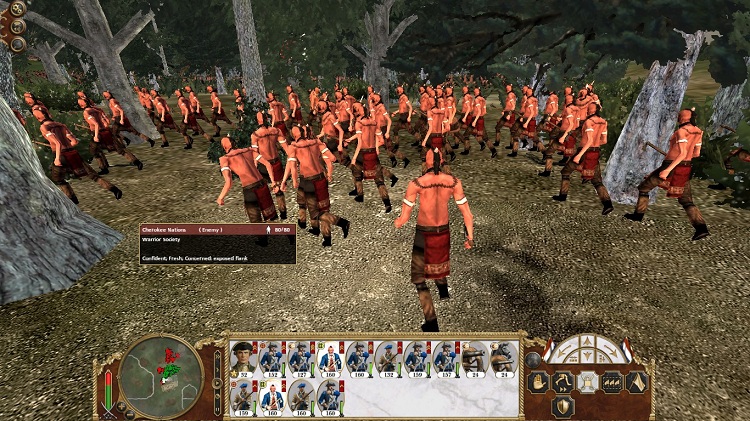
The natives used their knowledge of the local landscape to attack the Europeans were they least suspected it. The Dutch had hoped to oust the Chikasa garrison quickly, but were surprised by the appearance of a second Cherokee force.
 Without cannons of their own, the Natives moved forward in a mass to attempt to overwhelm the Dutch forces while a cavalry and warrior society contingent moved to try to fold the Dutch right flank, and spike their artillery.
Without cannons of their own, the Natives moved forward in a mass to attempt to overwhelm the Dutch forces while a cavalry and warrior society contingent moved to try to fold the Dutch right flank, and spike their artillery.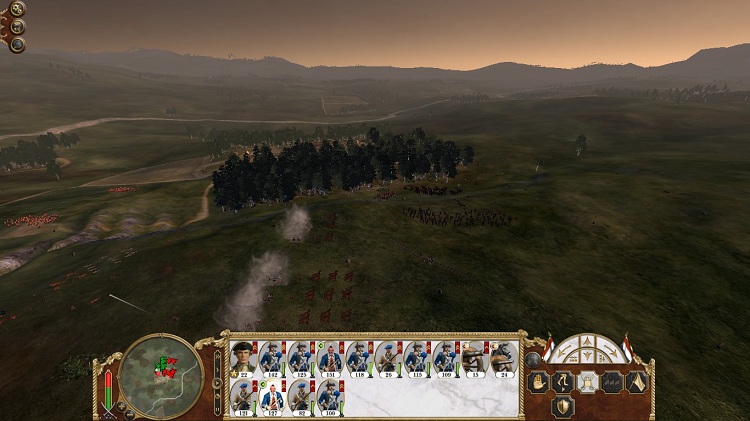
Natives coming around the exposed Dutch right flank. Native auxiliaries were sent to block them.
 The Dutch had deployed in a standard line with their cannons firing from behind on the hill top, trying to pick apart the Native cavalry. Their own native auxiliaries, these from South America were held in reserve to counter charge any natives that made it into the back line. These back line reserves charged down the right flank of the Dutch controlled hill top into the cavalry and native auxiliaries, forcing the native flanking force back.
The Dutch had deployed in a standard line with their cannons firing from behind on the hill top, trying to pick apart the Native cavalry. Their own native auxiliaries, these from South America were held in reserve to counter charge any natives that made it into the back line. These back line reserves charged down the right flank of the Dutch controlled hill top into the cavalry and native auxiliaries, forcing the native flanking force back.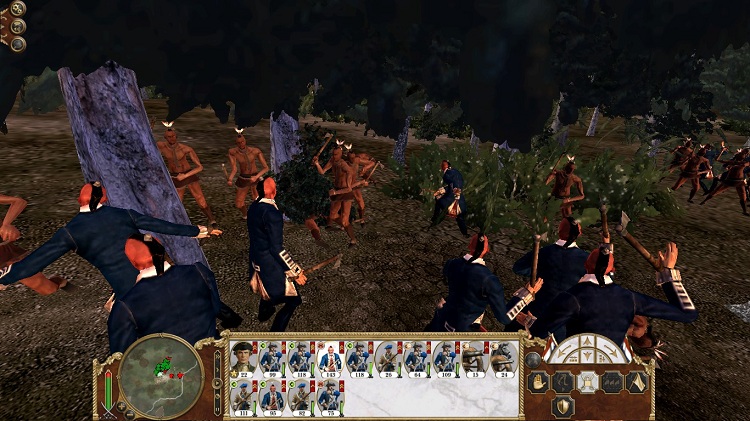
Dutch native militia from South America were an excellent match to the warrior societies of the Cherokee.
 Their general line quickly smashed through the native lines, pushing straight into the main camp of the Cherokee in the region. Following up straight from there, the Dutch advanced on the natives in Kentucky, fighting a similar battle against a similar native army. Pushing directly through, the Dutch gained complete control over the Cherokee territories, freeing them to move back east.
Their general line quickly smashed through the native lines, pushing straight into the main camp of the Cherokee in the region. Following up straight from there, the Dutch advanced on the natives in Kentucky, fighting a similar battle against a similar native army. Pushing directly through, the Dutch gained complete control over the Cherokee territories, freeing them to move back east.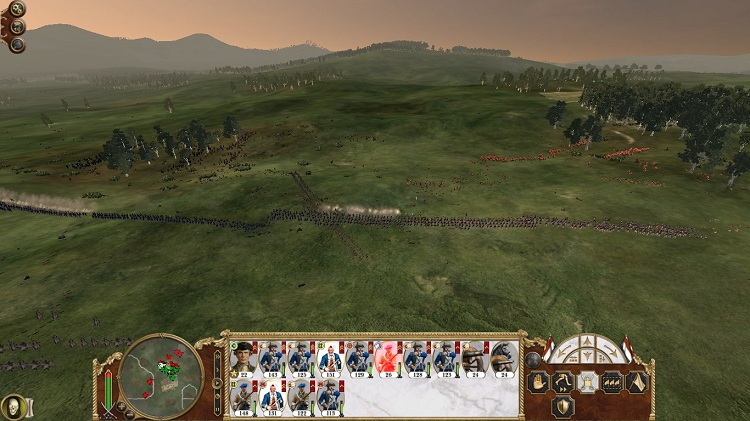
The Dutch push straight through to Kentucky, eliminating the last of the Cherokee defenders.
 Unfortunately, they were a long march away through the poor roads and hills of the region, meaning the garrison in Florida would be assaulted before those reinforcements could arrive. The siege of St. Augustine would occur just in time for the new decade, in February 29th, 1730.
Unfortunately, they were a long march away through the poor roads and hills of the region, meaning the garrison in Florida would be assaulted before those reinforcements could arrive. The siege of St. Augustine would occur just in time for the new decade, in February 29th, 1730.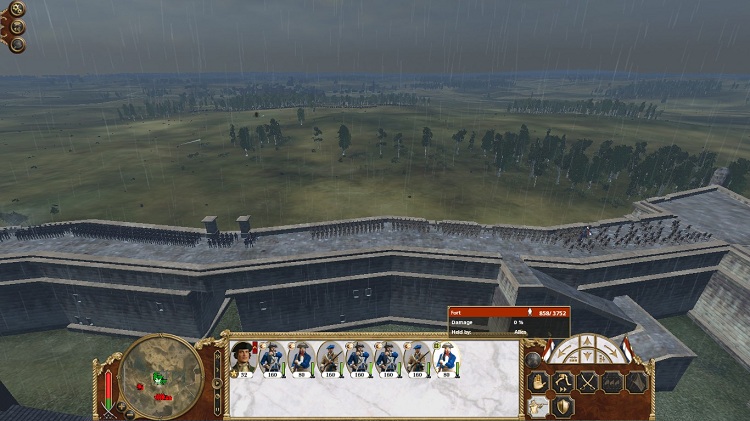
The Dutch in St. Augustine waiting for reinforcements or the British.
 Under normal circumstances, the tremendous advantage in cavalry the British held would have tipped the battle far too far in their favour for the Dutch to win, especially when their inferior infantry did not outnumber the British infantry. However, with the fort around St. Augustine, the British cavalry would prove next to useless. The British couldn't hope to start out the St. Augustine garrison, as the Dutch army from Kentucky would be arriving far before the garrison starved or died of attrition.
Under normal circumstances, the tremendous advantage in cavalry the British held would have tipped the battle far too far in their favour for the Dutch to win, especially when their inferior infantry did not outnumber the British infantry. However, with the fort around St. Augustine, the British cavalry would prove next to useless. The British couldn't hope to start out the St. Augustine garrison, as the Dutch army from Kentucky would be arriving far before the garrison starved or died of attrition.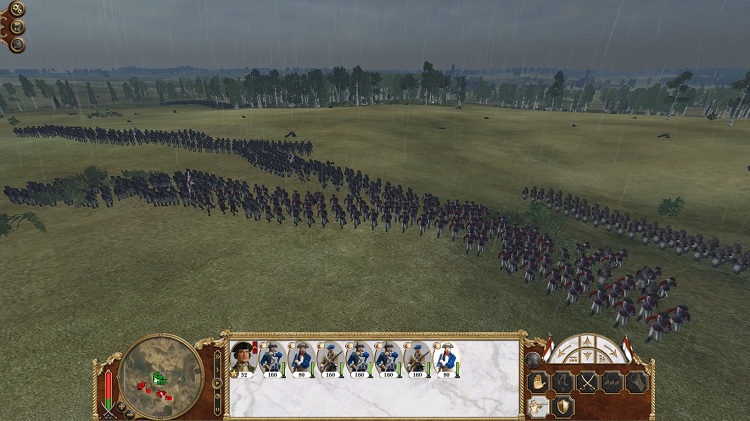
British infantry advancing through the rain.
 The day was cold and filled with torrential rain storms. The Dutch huddled along the length of their wall watched as the British infantry rushed to their walls, eager to storm the Dutch positions. Cannon fire hammered the fort, trying to form a breach for the cavalry to exploit. Other battalions of British infantry clamoured over the Dutch walls, but were repulsed by battalions firing from the battlements.
The day was cold and filled with torrential rain storms. The Dutch huddled along the length of their wall watched as the British infantry rushed to their walls, eager to storm the Dutch positions. Cannon fire hammered the fort, trying to form a breach for the cavalry to exploit. Other battalions of British infantry clamoured over the Dutch walls, but were repulsed by battalions firing from the battlements.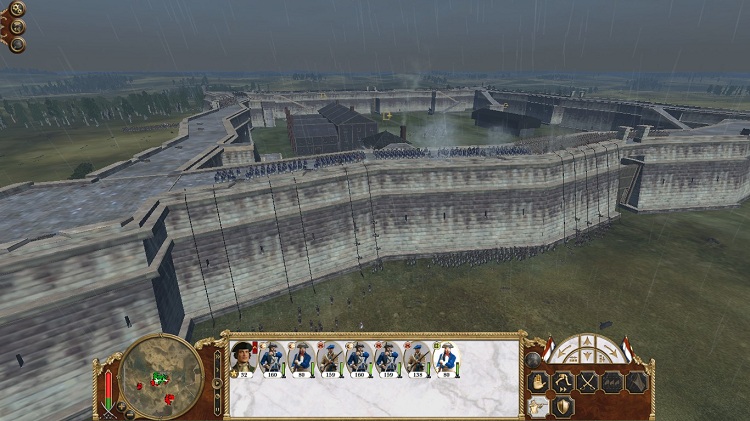
British infantry scaling the walls are repelled by Dutch defenders.
 That cannon fire, threatening to take down the Dutch walls forced the Dutch off of them and into their central courtyard. Battalions took up positions in their armoury and command HQ, but the gate houses were taken by the British along two sides, letting a wave of infantry and cavalry in without having to destroy the walls.
That cannon fire, threatening to take down the Dutch walls forced the Dutch off of them and into their central courtyard. Battalions took up positions in their armoury and command HQ, but the gate houses were taken by the British along two sides, letting a wave of infantry and cavalry in without having to destroy the walls.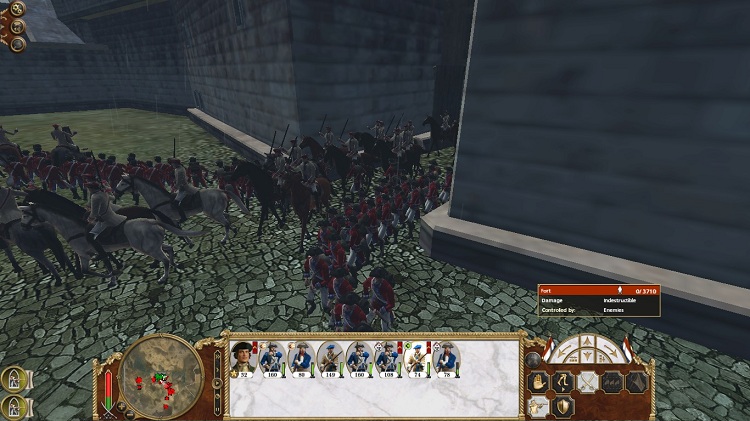
Cavalry and infantry swarmed through the opened gates.
 The Dutch, ready and in firing line through their courtyard were well positioned to defeat the British assault. The British who ran through the front gate were presented by the armoury, which had armed peasantry in the windows raining fire down on top of them. Wherever they attempted to get around to the building doors, they were gunned down by infantry deployed in line, firing in ranks. The gate house being too choked and crammed with troops trying to get in, and others attempting to retreat forced the British to withhold a greater cavalry assault, as the cavalry that was tricking in were mown down before they could achieve any sort of mass.
The Dutch, ready and in firing line through their courtyard were well positioned to defeat the British assault. The British who ran through the front gate were presented by the armoury, which had armed peasantry in the windows raining fire down on top of them. Wherever they attempted to get around to the building doors, they were gunned down by infantry deployed in line, firing in ranks. The gate house being too choked and crammed with troops trying to get in, and others attempting to retreat forced the British to withhold a greater cavalry assault, as the cavalry that was tricking in were mown down before they could achieve any sort of mass.
British troops trying to funnel through the tight gate house were put into a narrow kill zone
 This problem was absolved somewhat when the Dutch walls were battered to oblivion in several locations. The British line and cavalry massed along the breaches and gate and swarmed in. The Dutch had their infantry set in line after line of infantry, men fired through window slats in the armoury and HQ bunker killing dozens of riders as they rode in to overwhelm the Dutch.
This problem was absolved somewhat when the Dutch walls were battered to oblivion in several locations. The British line and cavalry massed along the breaches and gate and swarmed in. The Dutch had their infantry set in line after line of infantry, men fired through window slats in the armoury and HQ bunker killing dozens of riders as they rode in to overwhelm the Dutch.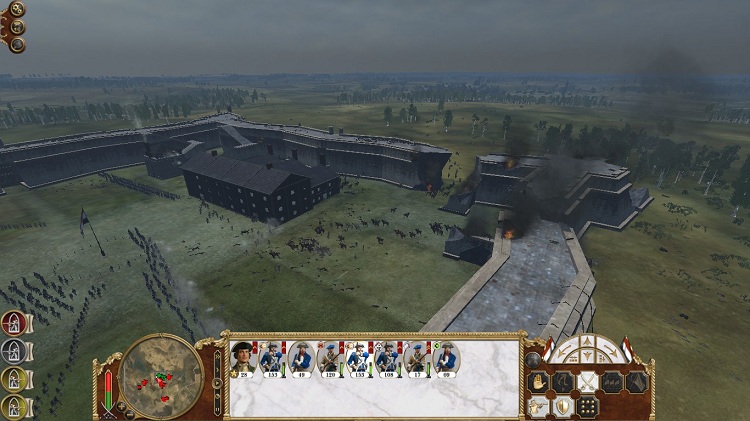
British cavalry charge through the breach.
 The cavalry did manage to make it into contact with a very significant mass against the Dutch line infantry, but with no room for any sort of maneuver within the fortress walls, they were forced to charge straight into the Dutch lines where they were killed by the hundreds. With the cavalry broken, the Dutch were in a good position to sally out and defeat the British artillery, finishing them off completely.
The cavalry did manage to make it into contact with a very significant mass against the Dutch line infantry, but with no room for any sort of maneuver within the fortress walls, they were forced to charge straight into the Dutch lines where they were killed by the hundreds. With the cavalry broken, the Dutch were in a good position to sally out and defeat the British artillery, finishing them off completely.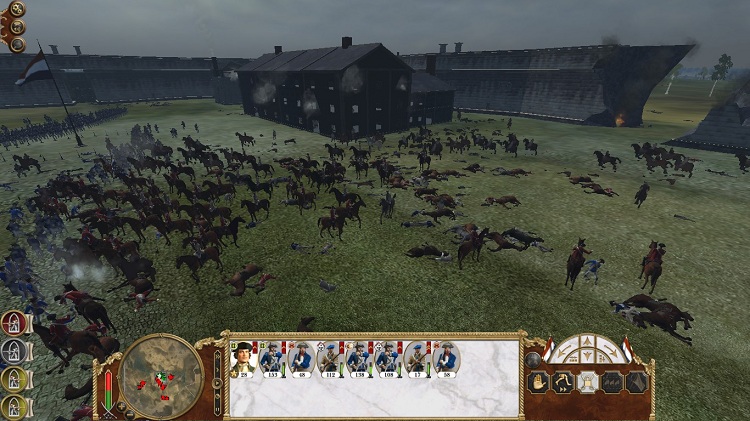
The British try for an old fashion cavalry breakthrough, with disastrous results.
 The defeat of the British army that had set sail from England years ago, had put the Dutch to ease, but their fleets near Portsmouth reported that it had already been replaced. Now, the British navy was on the loose, but at the very least was only a threat to Dutch trade and ports rather than presenting a threat to the back lines of the Dutch advance.
The defeat of the British army that had set sail from England years ago, had put the Dutch to ease, but their fleets near Portsmouth reported that it had already been replaced. Now, the British navy was on the loose, but at the very least was only a threat to Dutch trade and ports rather than presenting a threat to the back lines of the Dutch advance. Now, with the Dutch advanced stalled in the Americas due to the casualties taken defending against the British, as well as the attrition suffered by the army sent to deal with the Cherokee, the Statholder and his ministers had to look elsewhere to advance, and they needed to do so soon. Election was coming within the year, and they had to prove to the population across their Empire that they were not on their back heel. A token advance along the Eastern coast of the Americas would have been sufficient to hearten the spirits of the voters in Amsterdam, Paris and Madrid, but that was no longer an option. Instead, the Dutch were forced into a somewhat premature advance into the Maratha’s remaining territory in India, and into Vienna in Austria.
Now, with the Dutch advanced stalled in the Americas due to the casualties taken defending against the British, as well as the attrition suffered by the army sent to deal with the Cherokee, the Statholder and his ministers had to look elsewhere to advance, and they needed to do so soon. Election was coming within the year, and they had to prove to the population across their Empire that they were not on their back heel. A token advance along the Eastern coast of the Americas would have been sufficient to hearten the spirits of the voters in Amsterdam, Paris and Madrid, but that was no longer an option. Instead, the Dutch were forced into a somewhat premature advance into the Maratha’s remaining territory in India, and into Vienna in Austria.
The Dutch besiege Vienna, the Austrian capital.
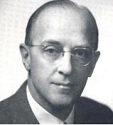 While the Maratha had remained somewhat strong despite losing many of their key economic centers, the Austrian were on the verge of collapse. Hungary had defected, forming their own kingdom while Poland had become by far the most dominant central European power. The Austrians were still powerful enough to challenge the Dutch with two armies. One marched to Munich while their other remained in Vienna to defend it. Similarly, the Dutch had their single army to hold Munich, primarily their militia that had been left behind, while the army under Vanderbilt marched on to Vienna. Both Austria and the United Provinces hoped to hold their own province with the garrison present long enough for their conquering army to make it back, or perhaps for both of their armies to outright destroy their opposite.
While the Maratha had remained somewhat strong despite losing many of their key economic centers, the Austrian were on the verge of collapse. Hungary had defected, forming their own kingdom while Poland had become by far the most dominant central European power. The Austrians were still powerful enough to challenge the Dutch with two armies. One marched to Munich while their other remained in Vienna to defend it. Similarly, the Dutch had their single army to hold Munich, primarily their militia that had been left behind, while the army under Vanderbilt marched on to Vienna. Both Austria and the United Provinces hoped to hold their own province with the garrison present long enough for their conquering army to make it back, or perhaps for both of their armies to outright destroy their opposite. Make no mistake, the Austrians on the whole had no means to defeat the Dutch. Their war weary population had nearly attempted to form a republic on Dutch ideals, and they could not hope to both defeat the Dutch and carry on to greater conquests and glory. However, they could damage the Dutch enough to force a peace treaty favouring the Austrians and British.
Make no mistake, the Austrians on the whole had no means to defeat the Dutch. Their war weary population had nearly attempted to form a republic on Dutch ideals, and they could not hope to both defeat the Dutch and carry on to greater conquests and glory. However, they could damage the Dutch enough to force a peace treaty favouring the Austrians and British. And these were the attacks the Dutch had to resort to in hopes that the Republican party would once again take the reins. This election was a big one. While the Dutch elections had become increasingly convoluted as they acquired more land, this was the first years where the Statholder had officially become the military ruler of the entire Western Atlantic Federation. The Statholder had traditionally been the Dutch wartime ruler over the United Provinces, and while their power was generally limited during peace time, the expanding and expensive war that the Dutch were entrenched in forced the Statholder to become the official military leader in Spain, France and their half of Germany.
And these were the attacks the Dutch had to resort to in hopes that the Republican party would once again take the reins. This election was a big one. While the Dutch elections had become increasingly convoluted as they acquired more land, this was the first years where the Statholder had officially become the military ruler of the entire Western Atlantic Federation. The Statholder had traditionally been the Dutch wartime ruler over the United Provinces, and while their power was generally limited during peace time, the expanding and expensive war that the Dutch were entrenched in forced the Statholder to become the official military leader in Spain, France and their half of Germany.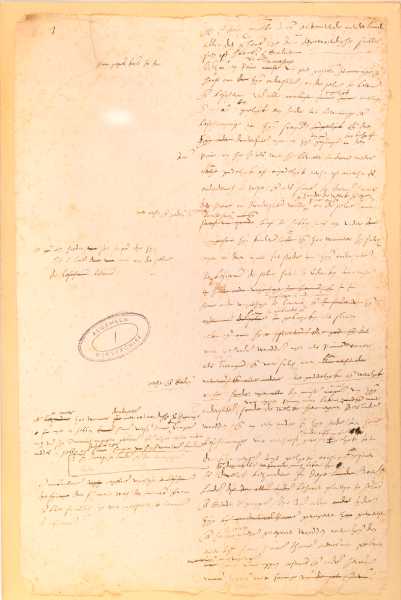
The act of abjuration was partly applied across the European holdings of the United Provinces. While modified to be contemporary to the times, it granted specific powers and responsibilities to local ministers giving up a lot of general power to their holdings, but getting consolidated power during emergencies to the Statholder and indirectly, war time powers to the Dutch ministers.
 This meant the Dutch election was to some degree open to all nations under Dutch control. A big risk for the Republican party. The ministers had reasoned that the Orange party, if elected would at least be militant minded enough to win the war, but at this time they needed military solidarity rather than trying to manipulate the French and Spanish into joining the Dutch army, or the Federation army.
This meant the Dutch election was to some degree open to all nations under Dutch control. A big risk for the Republican party. The ministers had reasoned that the Orange party, if elected would at least be militant minded enough to win the war, but at this time they needed military solidarity rather than trying to manipulate the French and Spanish into joining the Dutch army, or the Federation army.  To a degree, the titanic population of the Dutch Empire made election a long term project. Election of the Statholder was rife with corruption, errors and bias, especially in terms of campaigning. The election itself had to be held over a year prior to the actual official election date, with over a million tallies marked.
To a degree, the titanic population of the Dutch Empire made election a long term project. Election of the Statholder was rife with corruption, errors and bias, especially in terms of campaigning. The election itself had to be held over a year prior to the actual official election date, with over a million tallies marked. Thankfully, the election only offered two candidates, them being the Orange and Republican parties. The idea of other parties was not feasible, as the French would have immediately taken over the Federation thanks to their tremendous population.
Thankfully, the election only offered two candidates, them being the Orange and Republican parties. The idea of other parties was not feasible, as the French would have immediately taken over the Federation thanks to their tremendous population.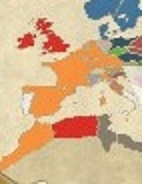
The gigantic size of the Dutch Empire. Even with their exclusive voting laws, the Dutch had to poll over a million citizens from across their Empire, many of them concentrated in Paris.
 With “election fever” sweeping the Empire, the Dutch ministers were more focused on being reelected rather than doing what was best for the war, or even the country. With this attitude, how would their decisions over the year influence the war?
With “election fever” sweeping the Empire, the Dutch ministers were more focused on being reelected rather than doing what was best for the war, or even the country. With this attitude, how would their decisions over the year influence the war? Next we will be going over the mythology of St. Nicholas. In half an hour, we’ll be talking about being Santa, the best gifts for your kids, this year. World news has been moved back an hour for today and for the rest of the Christmas season. If you want news of the current war in the Middle East please channel in to BBC radio 1. David Stephenson will be presenting more on the 80 years war in 3 days.
Next we will be going over the mythology of St. Nicholas. In half an hour, we’ll be talking about being Santa, the best gifts for your kids, this year. World news has been moved back an hour for today and for the rest of the Christmas season. If you want news of the current war in the Middle East please channel in to BBC radio 1. David Stephenson will be presenting more on the 80 years war in 3 days.